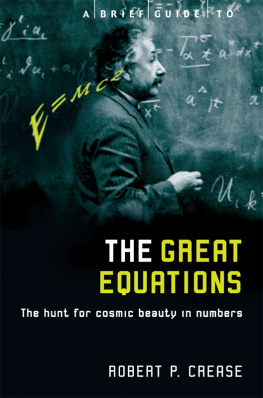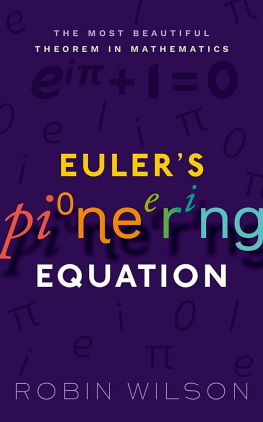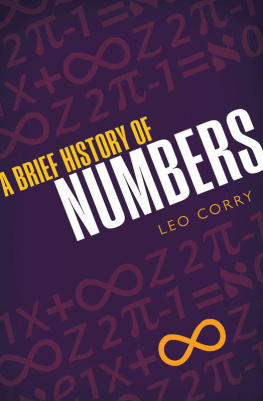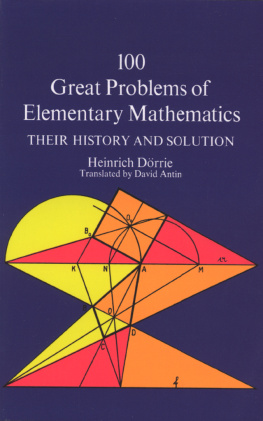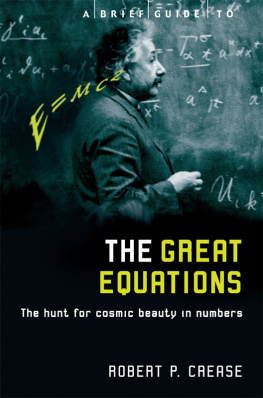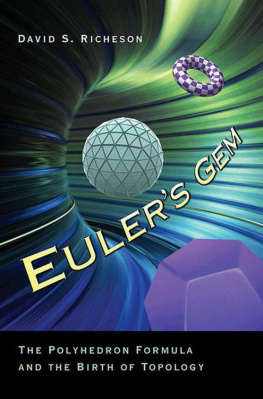Hachette Book Group supports the right to free expression and the value of copyright. The purpose of copyright is to encourage writers and artists to produce the creative works that enrich our culture.
The scanning, uploading, and distribution of this book without permission is a theft of the authors intellectual property. If you would like permission to use material from the book (other than for review purposes), please contact permissions@hbgusa.com. Thank you for your support of the authors rights.
Published by Basic Books, an imprint of Perseus Books, LLC, a subsidiary of Hachette Book Group, Inc.
The publisher is not responsible for websites (or their content) that are not owned by the publisher.
Library of Congress Cataloging-in-Publication Data has been applied for.
when I ran across a ranking by math experts of the most beautiful theorems, I tuned in. I decided to treat it as a pop quiz: How many of them could I dredge up from my distant undergraduate days as a math major? Alas, Im afraid I flunked. Still, I was consoled by being able to recall nine of the top 10 (of two dozen). But the No. 1 beauty, an equation known as Eulers formula, bothered meId seen it before, yet couldnt remember going over it in school.
Its probably overrated, I thought, a little defensively. Lacking arcane symbols or other bona fides of serious mathematical artistry, it features only numbers, and just five at that (as its usually written). True, three of them are designated by letters, showing theyre special. But the equation itself looks hardly more scintillating than a confused first graders 2 + 1 = 0. See: ei + 1 = 0.
I was certainly familiar with Leonhard Euler (pronounced oiler), the eighteenth-century mathematician its named after. Hes known as the Mozart of mathematics, and his fingerprints, so to speak, were all over the pages of my old math books. But that didnt tell me much. And as the formula started playing through my head like a tune whose provenance maddeningly eluded me, I discovered via Google that a number of authorities on math have considered it not only beautiful, but also one of the most remarkable results in the history of mathematics. Among them was one of my heroes, Richard Feynman, a brilliant theoretical physicist who worked on the Manhattan Project, won a Nobel Prize, led the investigation of the 1986 Space Shuttle Challenger disaster, and, to top it off, radiated almost superhuman joie de vivre . Why did this simple-looking little formula light up his multi-gigawatt mind?
OK, I decided, its time for some investigative reporting. Although Id moved on to science writing after college, Id warded off total math-muscle atrophy by acting as my eye-rolling kids tragicomically enthused mathematics tutor, all the way through high school calculus in the case of my son. So I looked up the derivation of Eulers formulaits straightforward if you know a little calculusand reconnoitered its history and significance. And like many math lovers before me, I came away thinking, wow, or, more precisely, WOW!
For one thing, it effectively compresses about two millennias worth of big ideas in mathematics into a fantastically small package, among them the nature and uses of infinity ( is basically tucked away inside the formula), the weird ubiquity of the number in math, the great utility of the misleadingly named imaginary numbers, and the wonderfulness of nothing, i.e., zero. What really grabbed me, though, was the fact that on his way to the formula, Euler uncovered a set of hidden connections among math concepts that many students go over in high school without ever realizing that theyre deeply linked in a way that could aptly be described as scary-cool. (That is, several levels of cool up from merely awesome.)
So I got the beauty thing. But I still wondered about the blank space in my memory where I should have had a beauty queen. Continuing the investigation, I pulled out my college calculus books, which Id kept as trophies for all the hours I spent hunched over them. Eulers formula wasnt listed in their indexes. Paging through them, I finally found a single, fleeting mention of a general equation (also Eulers) from which the most beautiful formula is derived as a special case. The closest thing to ei + 1 = 0 that I could find was an exercise whose answer happened to be a version of it.
So thats it, I thought. I didnt forget Eulers formula. , it got infinitesimal shrift during my student days. Come to think of it, the most beautiful equation didnt come up in any of my sons high school math courses either.
This last thought led to my recollecting how I knew all too much about those courses. Its true, I inwardly sighed, as Quentins tutor I was more on top of his daily math assignments than he was. A budding artist, he regarded math classes as a boring waste of time. And by the time he left for college, I was seeing double when I looked at his math books. One of the two images I saw was the engaging one I knew as a math lover. But the other image was the one that I knew he saw. them in their tracks, that they cant understand. The homework is unrelenting, the algorithms get longer and trickier, the quizzes keep coming. Sooner or later, many of them hit the wall.
You can probably see where Im going with this. My next thought was: If only Quentin, as well as millions of other people out there who regard math as the supreme soporific, could experience the frisson I felt when reliving Eulers great discovery. But lets get real, I firmly told my inner soliloquist, who was already whispering, Do a book! in my ear. Theres no way that people who have forgotten most of their high school math could experience that epiphany. Preposterous. Forget it. The very idea could do incalculable harm to my reputation as a somewhat grounded thinker.
And then, of course, I sat down to write this book. Well, thats a slight exaggeration. I mulled the idea over for about a year. Finally I remembered how American philosopher Oets Kolk O.K. Bouwsma had overcome his own hesitation to put together a book hed had doubts about: I have tossed a coin and it came down as I thought it would, he explained. It stood on its edge.
So here we are. But before you delve into this bookor turn away from itplease finish the intro. Ill be brief.
One reason I flattened the coin is that Eulers formula offers a very rare combination of beauty, depth, surprise, and, most importantly for my purposes, understandabilityfew profound math results are as accessible as it is. (Although it does take some explaininga short books worth, apparently.) And I knew that writing about it would give me license to roam across the history of mathematics as I went over the ideas that it so cunningly encapsulates.
Also, the formula isnt just a math version of abstract art. Long after Eulers era, scientists and engineers realized that the general equation mentioned above (the conceptual parent of


